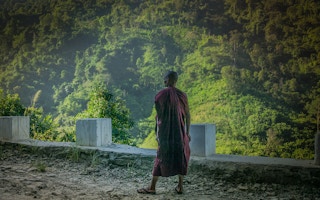Campaigners in the Tanintharyi region of southern Myanmar have urged international donors to support community conservation efforts, rather than what they see as a top-down approach that excludes indigenous groups.
Supporters of the Conservation Alliance of Tanintharyi (CAT) are opposing a $21 million development project, called Ridge to Reef, backed by the Myanmar government, the United Nations Development Program (UNDP), The Global Environment Facility (GEF) and Fauna & Flora International (FFI).
In a report released on Friday, CAT documents resistance in local communities to the imposition of protected areas, as well as their ongoing efforts to protect fish breeding grounds and water catchment areas, along with establishing their own protected community forests.
The proposed Ridge to Reef project would cover about 35 per cent of the Tanintharyi region and aims to protect some of the best preserved lowland evergreen forests in Southeast Asia. It would also include some of the largest remaining mangrove forest in mainland Southeast Asia, along with about 800 islands.
The importance of the area’s forests was recently underscored by the capture of a tiger in a camera trap set up by FFI, which it says is just one of the 166 threatened species that call the area home.
But it is not just wildlife that attracts outside interest. Valuable hardwoods are prevalent throughout the forests in the Tanintharyi region and are still being stripped by illegal loggers and through government-approved concessions.
Agribusiness concessions are often used as a front for timber extraction, with only a token amount of planting on the concessions reported by local monitors, according to campaigners. The destruction of the mangroves, mostly to supply charcoal to neighbouring Thailand, endangers the coastline of the entire region, conservationists say.
The proposed 3.5 million acre conservation area would cover 225 villages and radically transform the lives of the indigenous people that live in them. The grassroots efforts to stop the proposed conservation area stem from a disagreement over the donors’ approach, rather than their intentions. There is widespread agreement that diverse ecosystems in the area should be protected, but local conservationists say they disagree over how best to achieve this aim.
Saw Min Yin, from Hin Hlaing village in Lenya-Boakbyin Township, called on the international conservation NGOs backing the project to support their ongoing conservation efforts and “not [to] dismiss indigenous communities, and respect the rights of indigenous communities to free, prior and informed consent”.
The coordinator of CAT, Naw Eh Htee Wah, speaking from the Tanintharyi region, told Monagabay that “the management plan or the conservation plan does not include people at all,” adding “we already have conservation systems; support that [instead].”
Naw Eh Htee Wah remains sceptical that large donor organisations will consider the communities in their decision-making given the amount of primary forest that has been handed out to businesses. “If they care about conservation, why do they give the concessions?”
“They clean all of the forest and they get a lot of profit.”
One of the primary sources of survival for these communities is upland cultivation, which provides both food and income through a system of community land ownership, shifting crop rotation and a communal decision-making process called “Kaw”.
The Myanmar Forestry Department, one of the partners in the Ridge to Reef project, has been reluctant to prioritize tackling deforestation, and has been criticized for a lack of transparency over how much of the 30 per cent of Myanmar’s land under its control is actually forested, according to campaigners.
The stripping of Myanmar’s forests accelerated under the military junta, which took power in 1988 before transitioning to a hybrid of civilian and military rule in the early 2010s.
According to the United Nations Food and Agriculture Organization, between 2010 and 2015 Myanmar experienced the third-highest loss of forest in the world after Brazil and Indonesia, with an estimated annual loss 1.3 million acres, or around 2 per cent of the country’s total forest cover.
Despite often placing the blame for deforestation on ethnic minority groups, areas of the country outside of government control have fared significantly better, according to satellite data. Between 2002 and 2014, Mon and Karen states, as well as the Tanintharyi region, were all found to have higher rates of deforestation in government-controlled areas. In Tanintharyi, areas controlled by ethnic minority armed groups had an average of 6 per cent less deforestation.
Residents are also concerned that the project may jeopardise the region’s fragile ceasefire.
The Karen National Union (KNU) has been involved in a bitter civil war against the Myanmar military since 1949. According to the report, by excluding the KNU, the project violates the 2015 ceasefire agreement, while gaining the prior, informed consent of indigenous communities is required by the UNDP and under the UN Declaration on the Rights of Indigenous Peoples.
A review of the project in 2014 by GEF, one of the partners, found there had been “omissions” when interacting with local communities and in the preparation of the project, adding that indigenous people were not considered in its design.
In July 2018 CAT made a formal complaint to the GEF’s conflict resolution commissioner and in August sent it to UNDP’s accountability office, triggering a compliance review process with its Social and Environmental Compliance Unit (SECU).
The complaint alleges that, as well as the 225 villages who would be displaced as a result of the project, internally displaced people who fled the civil war would also be unable to return to their land. That investigation is reportedly ongoing, though due to the Covid-19 outbreak it remains in limbo after a field trip due to take place in February was postponed.
Forestry department officials and FFI representatives did not respond to requests for comment by publication time.
This story was published with permission from Mongabay.com.










